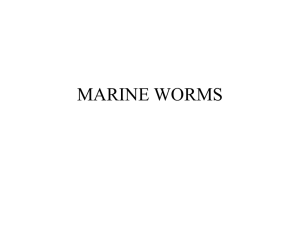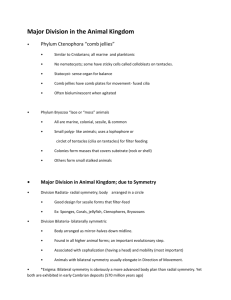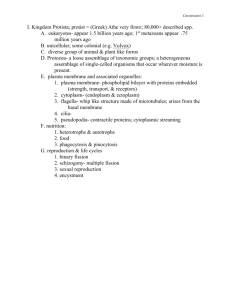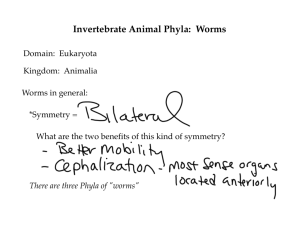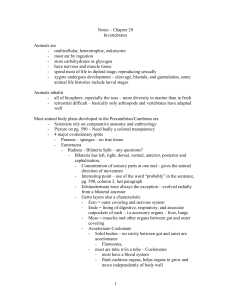Ocean Invertebrates & Ocean Vertebrates
advertisement
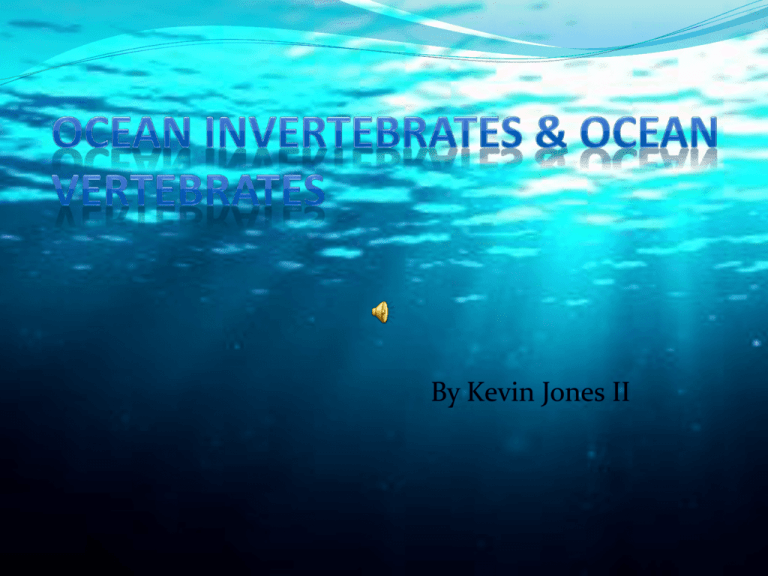
By Kevin Jones II List of names under Phylum: Porifera Cnidaria Platyhelminthes Nematoda Annelida Mollusca Arthropoda Echinodermata Chordata The phylum of animals to which sponges belong the most primitive true animals There are between 9,000 and 15,000 species of sponges classified under phylum Suspension feeders Have no: Digestive system Circulatory systems Respiratory systems Nervous systems Aplysina archeri (Stove-pipe Sponge) Agelas conifera, the Brown Tube Sponge nationalgeographic.com nationalgeographic.com The Stovepipe Sponge is a filter feeder and eats food such as plankton or suspended detritus as it passes by them. It reproduces both asexually and sexually. Sperm is released into the water column where it floats and then settle down on substrate and begins to reproduce cells and grow. It takes hundreds of years for a single sponge to mature and it actually never stops growing until it dies. Typically smooth walled, brown to tan in color, smooth, velvety in appearance. Grow in clusters, joined at base. (below) Found on protected coral and rocky reefs on walls in canyons and crevasses They are able to filter many litres of sea water every few seconds. Sponges can exude highly toxic chemicals and so have very few predators apart from nudibranchs, sea stars, sea urchins and umbrella shell. Coral, jellies, sea anemones, siphonophores contains about 9,000 or 10,000 mostly marine species have stinging cells deployed on tentacles stinging cells is the explosive cell containing one giant secretary organelle are called Cnidocyte A cnidocyte fires a structure that contains the toxin, from a characteristic sub-cellular organelle Some species of sea anemone can live 50 years or more. food taken in waste expelled through the mouth two forms: medusa: jellyfish polyp: coral & sea anemone exhibit radical symmetry Cnidaria (Examples) Brain coral (Faviidae) Sea anemones and clownfish tolweb.org Sea anemones live in a symbiotic relationship with the 29 species of clownfish. The clownfish are protected by a mucus layer that makes them immune to the anemone's sting. Clownfish live within the anemone’s tentacles getting protection from predators, and the anemone eats the scraps from the clownfish’s meals clownfish also help keep the anemone's tentacles clean The group contains a breeding pair and some nonreproductive smaller males. When the female dies, the dominant male changes sex and becomes the female. fossilmuseum.net Brain corals are found in shallow warm-water coral reefs in all the world's oceans. The life span of the largest brain corals is 900 years Brain corals extend their tentacles to catch food at night. Brain corals use their tentacles for protection by wrapping them over the grooves on their surface. The surface is hard and offers good protection against fish or hurricanes Platyhelminthes (ocean worms) Flatworms, flukes, tapeworms Most primitive organism with a central nervous systems Lack true respiratory and excretory systems Exist as parasites and free-living predators and scavengers Exhibit bilateral symmetry Found in fresh water Platyhelminthes (examples) Planaria Flukes picasaweb.google.com tropicalfishkeeping.com a flatworm that lives on human beings or in other animals Many of these live on the gills or skins of fish, while others live in frogs Most flukes require two or more hosts to complete their life cycles infest such parts of the body as the lungs, liver, blood, heart, or intestines Are free-living, primarily carnivorous flatworms-with a three-branched digestive cavity eat other living, as well as dead, invertebrates, detritus or decaying organic matter, and some prefer diatoms They are found beneath rocks, logs, or dead leaves in springs, spring brooks, ditches, wetlands, streams, and lakes Nematoda (ocean worms) Roundworms they would be the most diverse phylum of, and one pseudocoelomates of the most diverse of all animal phyla, but discussion is in progress to determine whether the phylum is to be split or not Most primitive organisms to have a flow-thru digestive system Exhibit bilateral symmetry Nematoda (Examples) Hookworm lives in the small intestine of its host, which may be a mammal such as a dog, cat, or human Two species of hookworms commonly infect humans, Ancylostoma duodenale and Necator americanus much smaller than the giant roundworm susceptible children hookworms cause intellectual, cognitive and growth retardation, intrauterine growth retardation, prematurity, and low birth weight among newborns born to infected mothers thrives in warm earth where temperatures are over 18°C bioweb.uwlax.edu Eelworms Eelworms (also called Root Knot Nematodes) are tiny, almost microscopic, wormlike creatures that are very common in soil wide range of host plants, tomatoes one of the most critically affected very moist conditions in the soil Effects of an eelworm infestation include stunting, wilting, yellowing, reduction of flowering, fruit set, and fruit development and sometimes even plant death. arbico-organics.com Annelida Segmented worms Most evolution advanced worms Bodies divided into segments Each segment can have its own: circulatory, excretory, nervous, muscular, and reproductive systems Exhibit bilateral symmetry 22,000 modern species They are found in marine environments from tidalzones to hydrothermal vents, in freshwater, and in moist terrestrial environments Chloeia flava. Leeches coastalbaits.com Segmented worms that belong to the phylum Annelida Leeches do not have bristles and the external segmentation of their bodies does not correspond with the internal segmentation of their organs They also have two suckers, one at each end Leeches live in freshwater environments Predominantly blood suckers that feed on blood from vertebrate and invertebrate animals This is one of the color variants called Chloeia flava. In the middle of each segment there's an U-shaped white line surrounding a dark center; in some animals the white lines surround a very narrow dark line. Average life span: 1-1.5 months 5-10 centimeters sports an array of poisonous bristles defend against animals lacking hard exoskeletons Mollusca Clams, snails, octopus, squid, sea slug (nudibranch) 2nd largest number of species Most have external or internal shell Squid- largest invertebrate Octopus- most intelligent invertebrate Verrucosa Caribbean Reef Octopus Inhabits many reefs and grass beds throughout the western Atlantic, Bahamas, Caribbean, and northern South America generally does not venture inland towards seas very short lifespan, generally only a year to a year and a half the male will begin mating by wrapping around the female and then using a special tentacle will attach a sperm packet to the female. The male will die shortly after this moment, but the female will continue to live until the eggs hatch, usually 500 per batch. She will not eat during this time, but she will protect the nest fiercely from all invaders marinebio.org There are over 500 living species of venerid bivalves, most of which are edible, and many of which are exploited as a food source clams are characterized as bivalves with an external posterior ligament, usually a well demarcated anterior area known as the lunule, and three interlocking structures are also anterior lateral teeth, anterior to the cardinal teeth: one in the left valve, and two (sometimes obscure) in the right valve. The inner lower peripheries of the valves can be finely toothed or smooth. clamsnet.org Arthropoda Lobsters, shrimp, crabs, barnacles, krill Largest number of species Most successful phylum 3 evolutionary advances: An exoskeleton Striated muscles Articulation Exoskeleton is molted at regular intervals Exhibits bilateral symmetry Arthropoda spiny lobsters The Japanese spider crab Adult spiny lobsters make their homes in the protected crevices and caverns of coral reefs, sponge flats, and other hard-bottomed areas inhabits tropical and subtropical waters of the Atlantic Ocean, Caribbean Sea, and Gulf of Mexico. Spiny lobsters get their name from the forward-pointing spines that cover their bodies to help protect them from predators. spider crab spider crab In its natural habitat, the Japanese spider crab feeds on shellfish and animal carcasses and may live for up to 100 years The Japanese spider crab has the greatest leg span of any arthropod, reaching 3.8 metres (12 ft) from claw to claw Echinodermata Sea star, brittle stars, sea urchins, sands dollars, sea cucumber Lack eyes or brains 5-section radically symmetrical body Approximately 13,000 echinoderm species are known from the fossil record Echinodermata (examples) Sea Star (Starfish) About 1,800 living species of starfish occur in all the world's oceans, including the Atlantic, Pacific, Indian, Artic and Southern Ocean regions. Suspension feeder and adaptations for feeding on specific prey. They have complex life cycles and can reproduce both sexually and asexually. Most can regenerate damaged or lost arms. sea cucumber All sea cucumbers are ocean-dwellers, though some inhabit the shallows and others live in the deep ocean. Sea cucumbers feed on tiny particles like algae, minute aquatic animals, or waste materials, which they gather in with 8 to 30 tube feet that look like tentacles surrounding their mouths. Chordata (Invertebrates and vertebrates) Tunicates (sea squirts), amphioxus, and salps Most advanced animal phylum Possess a stiffening “notochord” (invertebrates) More advanced phylum members are the vertebrates well represented in marine, freshwater and terrestrial habitats from the Equator to the high northern and southern latitudes Chordata (examples) Salps Lancelet blogspot.com Common in equatorial, temperate, and cold seas, where they can be seen at the surface, singly or in long, stringy colonies Cycle exist together in the seas—they look quite different, but both are mostly transparent, tubular, gelatinous animals that are typically between 1 and 10 cm (0.39 and 3.9 in) tall. Appear to be increasing in population Salps appear similar to jellyfish because of the simple body form and planktonic behavior, they are structurally most closely related to vertebrates, animals with true backbones Fish-like, marine creatures, forming the class Cephalochorda, of the phylum Vertebrata Lancelets grow up to about 5 centimetres (2.0 in) long, reaching 7 centimetres (2.8 in) at the longest A relatively poorly developed tail fin is present, so they are not especially good swimmers Comprise some twenty-two species of fish-like marine chordates with a global distribution in shallow temperate (as far north as Scotland)[2] and tropical seas, usually found halfburied in sand Are found in brackish or salt water, generally near the coast, and have been referred to several genera and many species Classified (following Worms) under the Kingdom Animalia, Phylum Chordata and Subphylum Vertebrata, are among the most structurally complex organisms. Agnatha (no jaws) Hagfishes, lampreys Have jawless snake-like bodies They have no distinct stomach, but rather a long gut, more or less homogenous throughout its length. Feed off other fish and mammals. They rely on a row of sharp teeth to shred their host. Anticoagulant fluids preventing clotting are injected into the host, causing the host to yield more blood. Are decomposers, eating mostly dead animals. They also use a sharp set of teeth to break down the animal Agnatha (examples) Hagfishes Lampreys realmonstrosities.com The Hagfishes are found in the family Myxinidae which contains 72 described species divided into 6 different genera. The hagfishes belong to the family Myxinidae, Hagfish are found in temperate seas in both hemispheres, but hagfish has not been found in the Red Sea The hagfish is famous for its habit of burrowing into dead or dying animals and devour them from the inside The hagfish is almost blind, but it has not problem detecting food since it is equipped with highly developed senses of touch and smell. Toptenz.net Lampreys are anadromous or fresh water, eel-shaped jawless fishes recognized by the large, rounded sucker which surrounds their mouth and by their single "nostril" on the top of their head. A large sucker surrounding the mouth, strengthened by an annular cartilage. Spine-shaped processes on gill arches are devoid of a mineralized skeleton, although traces of globular calcified cartilage may occur in the endoskeleton Chondrichthyes Sharks, skates, rays Skeleton made of cartilage Chondrichthyes (examples) Pelagic stingray Whale Shark montereybayaquarium.org You’ll find the rays' venom glands in paired grooves running the length of their barbed poison spines. Their sting—which is extremely painful—is usually not fatal Preferring warm waters, whale sharks populate all tropical seas feeding upside down favorite meal is plankton They are distinguished by their diamond-shaped bodies with rounded snouts and streamlined eyes that don’t protrude from their bodies reaching lengths of 40 feet (12 meters) or more, They scoop these tiny plants and animals up, along with any small fish that happen to be around, with their colossal gaping mouths while swimming close to the water's surface. The whale shark's flattened head sports a blunt snout above its mouth with short barbels protruding from its nostrils Osteichthyes Bony fish Possess hard, strong, lightweight skelekon Most numerous & successful of all vertebrates internal skeleton ossified (i.e., endochondral bone) swim bladder or lung present bony scales (ganoid, cycloid, ctenoid, or cosmoid) gill slits covered by an operculum (single external gill opening) late Silurian to Recent Osteichthyes (examples) Black Sea Bass Salmon nefsc.noaa.gov allfishingbuy.com Salmon eggs are laid in freshwater streams typically at high latitudes. The salmon spend about one to five years (depending on the species) in the open ocean, where they gradually become sexually mature live along the coasts of both the North Atlantic (the migratory species Salmo salar) and Pacific Oceans they are born in fresh water, migrate to the ocean, then return to fresh water to reproduce. generally first mature as females and some later become male. The sex change generally occurs over the winter when the fish They can be found in inshore waters (bays and sounds) and offshore They spend most of their time close to the sea floor and are often congregated around bottom formations such as rocks, man-made reefs, wrecks, jetties, piers, and bridge pilings. Sea turtles, sea snakes, marine crocodiles, marine lizards (iguana) Breathe with lungs Covered with scales Have special salt glands to concentrate and excrete excess salt from body fluids Examples Marine Iguanas Green Sea Turtle animals.nationalgeographic.com maligned marine iguanas of the Galápagos Islands are so famously homely, even Charles Darwin piled on, describing them as "hideouslooking" and "most disgusting, clumsy lizards." The shells of sea turtles are lighter and more hydrodynamic than the shells of turtles that live on land, allowing them to glide easily through water They're not pretty, with their wide-set eyes, smashed-in faces, spiky dorsal scales, and knotty, salt-encrusted heads Juvenile green sea turtles are carnivorous, feeding on jellies and other invertebrates Their population is not well known, but estimates are in the hundreds of thousands However, greens are the only herbivorous (vegetarian) species of sea turtle, feeding on sea grasses and algae. Snouts and small, razor-sharp teeth help them scrape the algae off rocks, and their laterally flattened tails let them move crocodile-like through the water Green sea turtles are found in all tropical and subtropical seas along the coasts of continents and islands Aves Sea birds Four groups: Tubenose (albatross) Pelicans Gulls Penguins Have special salt-excreting glands in their head to eliminate excess salts Obtain virtually all food from the sea Aves (examples) Kelp Gulls Kelp Gulls are omnivores like most Larus gulls, and they will scavenge as well as seeking suitable small prey also known as the Dominican Gull, breeds on coasts and islands through much of the southern hemisphere The nest is a shallow depression on the ground lined with vegetation and feathers. The female usually lays 2 or 3 eggs. Both parents feed the young birds. Brown pelican (Pelecanus occidentalis) guardian.co.uk They live in flocks of both sexes throughout the year Its habit of diving for fish from the air, as opposed to co-operative fishing from the surface The adult brown pelican is a large dark gray-brown water bird with white about the head and neck. Immatures are gray-brown above and on the neck, with white underparts. Although the Caribbean flickrhivemind.net Other fish preyed on with some regularity can include pigfish, pinfish, herring, sheepshead, silversides, mullet, and minnows, and they sometimes eat crustaceans, usually prawns. A single adult pelican can eat up to 1.8 kg (4.0 lb) each day Amphibia (not true ocean animals) Frogs, salamanders, toads Adapted to freshwater and moist land habitats Spotted Salamander The American Toad fcps.edu life123.com Eat earthworms, snails, slugs, spiders, millipedes, centipedes, isopods, and insects Large salamanders, sometimes growing over nine inches long Skin is bluish-black or dark gray, and they have two rows of round yellow or orange spots down their backs. Their bellies are slate gray. Large, growing up to 4 1/2 inches long. Full-grown adults are usually chubby. Varies in color All of them have warts, and some have a light stripe down their backs. Both male and female toads have a spotted belly, but the male has a darker throat. Mammalia Whales, dolphins, seals, sea lion, walruses, sea otters, manatees Most intelligent of marine vertebrates Most advanced of vertebrates Three orders: Cetacca Carnivora Sirenia Breathe with lungs Mammalia (examples) Humpback whales Dolphins kellylouiseposey.wordpress.com Humpback whales (Megaptera novaeangliae) are baleen whales (Suborder Mysticeti). They are one of 76 cetacean species, and are marine mammals. there are over 10,000-15,000 humpback whales worldwide. Humpback whales are an endangered species Humpback whales have a life expectancy of 45-50 years animals.nationalgeographic.com Dolphins live in saltwater but they can also live in freshwater locations Dolphins, like almost all mammals, give birth to live young, and nurse them with mammary glands, though it boggles the mind to imagine nursing underwater come to the surface of the water to get air References http://animals.nationalgeographic.com/animals/invertebrates/sea-anemone/ http://myfwc.com/research/saltwater/crustaceans-marine-arthropods/lobster/facts/ http://animals.howstuffworks.com/worms/fluke-info.htm http://www.montereybayaquarium.org/animals/AnimalDetails.aspx?enc=n3f4wmcSJaNkUaQTw44K 2w== http://animals.nationalgeographic.com/animals/fish/whale-shark/ http://animals.nationalgeographic.com/animals/reptiles/marine-iguana/ http://animals.nationalgeographic.com/animals/fish/whale-shark/ Walter J. Bock, "Chordata", in AccessScience@McGraw-Hill, http://www.accessscience.com , DOI 10.1036/10978542.133700, last modified: April 10, 2000.
